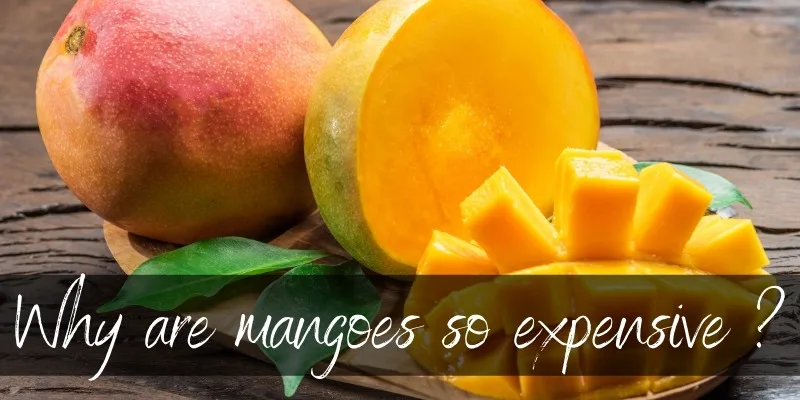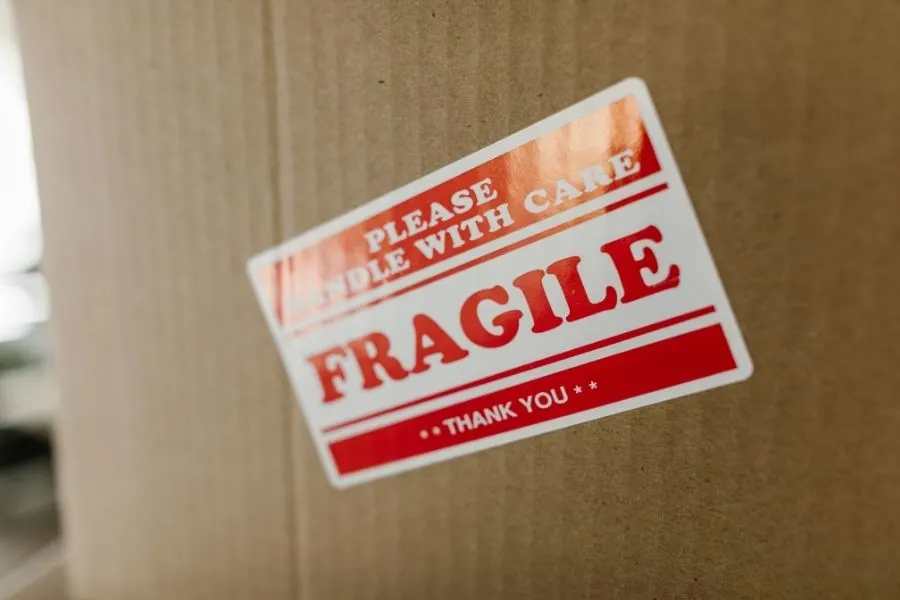If you’re looking for a tropical flavor, chances are you’ll decide on mango. It’s a fresh, sweet flavor with a slightly musky undertone. And it’s one of the most sought-after tropical fruits, along with pineapple and papaya.
There’s just something about mangoes that makes them sooooo delicious that everyone wants them. They come with a hefty price tag though. Often they’re sold per item, and it can get to $4 per mango at the cheapest !
So what gives ? Why are mangoes so expensive ? As fellow mango lovers, we’re going to find out why one of our top 5 fruits is so darn pricey !

Why are mangoes so expensive ?
Mangoes are expensive because they don’t grow in the countries that consume them the most. Mango is a tropical fruit, usually grown in India and Southeast Asia. This means shipping fees, middlemen, supermarket price markups, handling costs, fees for spoiled fruit during transport, and so on.
There’s also the fact that mangoes are fairly fragile, in that they don’t last very long on shelves. All of this adds up, and the final price is what you see in your local grocery store.
Read also: Best Mango Chutney Substitutes
1. Mangoes grow in areas near the tropic
Since mangoes are tropical fruits that are native to India, the trees need certain weather conditions to grow and produce fruits. India is the largest mango producer globally, followed by China, Thailand, and Mexico. And while some mango species can grow in the United States, the juiciest and more commercial kinds grow in places with warmer weather.
Thanks to the border proximity, Mexico ships the largest number of mangoes to the United States, around 80 million boxes of Mexican mangoes enter the US every year. Brazil exports to Europe around 100 tonnes of mango every year. And if we talk about Australia, mango trees grow in the north part of the countries while most of the population lives in the south, so shipping also comes as a major factor for prices.

All of that means that farmers and producers need to take a lot of things into consideration when shipping mangoes:
- Shipping fees.
- Transportation.
- Package.
- Currency exchange.
- Potential fruit loss.
That mango that you find in your local grocery? It probably had a long trip before you decided to grab it for dessert. That’s why mangoes are mangoes so expensive.
However, suppose you live or move to a tropical area. In that case, all of these transportation processes will reduce because mangoes can grow locally. That’s why it’s cheaper to buy mangoes (and pretty much any other fruit) that can grow near the area where you live.
Read also: Mangosteen VS Mango
2. Mangoes are heavy and fragile
Mangoes have a ton of health benefits and that’s why so many people love them. But another factor that comes into play for deciding its price is that it’s a very fragile fruit.
An average mango weighs around 7 oz (200 gr) and it has a weak shell that protects the juicy center. They need to be packaged efficiently in a way that they don’t smash into each other during transportation. But the fact that they’re somewhat heavy, means that it needs to be packed inside a resistant material that isn’t too hard (so it won’t smash mangoes) but also not too soft (so that mangoes won’t break it.)

Some of the best mango varieties don’t have a very long shelf life, and sellers take that into consideration. The typical shelf life of an average mango is between seven to fourteen days. This is one of the reasons that explains why are mangoes so expensive.
The National Mango Board has established a standardized packaging method to optimize the distribution of mangoes grown locally and internationally. But even with that, distributors often have to deal with a few rotten or smashed mangoes on their journey. And given the natural properties of this fruit, shipping and distribution help make it an expensive fruit in non-tropical areas.
3. Mangoes grow in seasons
Well, while technically you can find mango sellers at any moment during the year, there is a point in which the trees are mass-producing this delicious fruit.
Mango season usually happens during the warm months of spring and summer. which is usually between March and August. However, the peak season is between June and July, which are typically hot months in tropical countries. Mango trees start producing mangoes in a relatively short amount of time and in large amounts.
Buying mangoes out of season is a reason why mangoes are so expensive. Wait for the mango season to come and enjoy what the it has to offer.
Read Also: Can You Eat Unripe Mango?
Mango popularity and demand
Mangoes are the so-called King of Fruits. They are incredibly popular in places where they grow locally like India, China, and their neighboring countries. In fact, while India is the biggest mango producer, it’s also the biggest mango consumer. Most of India’s export goes to the closest countries.
Mango popularity in non-tropical countries has been increasing over the past decades. A lot of factors have to do with this phenomenon.
One of the factors is migration, more and more people from tropical areas like South America and South-East Asia are moving to non-tropical areas like the US and Europe. These migrants become a potential market for mango producers worldwide because they would obviously like to buy a fruit that reminds them of their home country.
Another factor is that globalization and international transportation have made mango a more attractive fruit to consumers. The Netherlands handles around 55% of all of the mangoes that go to Europe. They are imported to the Netherlands, which then exports them to other parts of Europe.
However, mango is not as popular in non-tropical places as it is in areas where it can grow for obvious reasons. People will always prefer fruits produced locally because they’re cheaper and easier to find. Still, we can’t ignore the growing mango popularity that has given the farmers extra motives to enhance and improve cultivating and transportation practices.
To summarize
Mangoes are a very popular and nutritional fruit that everyone will benefit from eating. But the fact that it needs to be transported from tropical areas to colder climates and move for hundreds of kilometers helps to make this fruit a little costly alternative. And the fact that is fragile and doesn’t have a very long shelf life explains why are mangoes so expensive.
Still, the mango demand is growing year by year in almost every country, improving shipping and cultivating practices. Maybe in the future mango farms will come up with ways to make its shipping safer and reduce the total cost of production.
This would mean that prices will probably become more accessible as time passes. In the meantime, you can wait until the mango season to benefit from the mango qualities at the best price.

